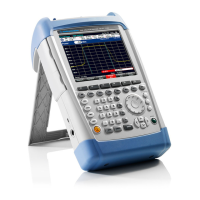Measurement Basics
R&S
®
FSW-K40
27User Manual 1173.9286.02 ─ 15
Figure 4-4: Sample size included in trace smoothing
The application smoothes the trace only after the measurement has been finished and
the data has been analyzed and written to a trace. Thus, smoothing is really just an
enhancement of the trace display, not of the data itself. This also means that smooth-
ing is always applied after any other trace averagings have been done, as these hap-
pen during the measurement itself.
You can turn trace smoothing on and off for all traces individually and compare, for
example, the raw and the smooth trace.
Linear smoothing is based on the following algorithm:
2
1
2
1
1
'
n
sx
n
sx
xy
n
sy
Equation 4-1: Linear trace smoothing
Logarithmic smoothing is based on the following algorithm:
2
1
2
1
10
10
10
1
log10'
n
sx
n
sx
xy
n
sy
Equation 4-2: Logarithmic trace smoothing
y(s) = logarithmic phase noise level
4.6 Frequency Determination
Nominal frequency
The nominal frequency is the output or center frequency of the DUT. To get correct
and valid measurement results, the application needs to know the real frequency of the
DUT.
Frequency Determination

